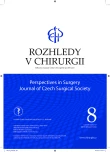Pleural empyema – single center experience
Authors:
J. Doležal; Š. Vejvodová; J. Vodička; V. Špidlen
Authors‘ workplace:
Chirurgická klinika, Univerzita Karlova, Lékařská fakulta v Plzni, Fakultní nemocnice Plzeň
Published in:
Rozhl. Chir., 2018, roč. 97, č. 8, s. 379-383.
Category:
Original articles
Overview
Introduction:
Retrospective analysis of a group of patients treated for pleural empyema in the Department of Surgery, University Hospital Pilsen, over the last ten years.
Method:
We evaluated a group of patients treated for pleural empyema in the Department of Surgery, University Hospital in Pilsen, during the period 2007−2016. We focused on the demographic data of this group, the causes of empyema in these patients, surgical procedures performed in connection with empyema, the microbial species found in empyema, and, last but not least, on morbidity and lethality.
Results:
We treated 103 patients with pleural empyema during the above period − 80 men (77.7%) and 23 women (22.3%) aged 23–83 years (average age 59.4 years). 64 patients had a history of surgical or invasive procedure (62.1%). The length of history was traceable in 55 patients (53.4%) and was 23.1 days on average, remaining unclear in the rest of the group. 1/3 of cases were metapneumonic empyemas, 1/3 postoperative empyemas and 1/3 of the cases were due to other reasons. The most commonly cultivated bacterial genus was Streptococcus, species Staphylococcus aureus. The most common surgery was chest drainage (51%). 13 patients died (lethality 12.6%) after surgery, the most common cause of death being sepsis; postoperative morbidity was 34%.
Conclusion:
Pleural empyema is a serious condition with very high morbidity and lethality. Surgical procedures done to manage empyema are associated with a very high risk of necessary reoperation. Positive mycological culture from empyema seems to be associated with a higher risk of complications and death.
Key words:
empyema – thoracic drainage – thoracotomy – lung decortication – videothoracoscopy
Sources
1. Hippocrates. de addectionibus interioribus. In: Littré, É, ed. Oeuvres complètes d'Hippocrate, vol. 7. Paris, France: Bailliére; 1851 (reprinted Amsterdam: Hakkert, 1962): 166−302. Google scholar.
2. Tsoucalas G, Sgantzos M. Hippocrates (ca 460-375 BC), Introducing thoracotomy combined with a tracheal intubation for the parapneumonic pleural effusions and empyema thoracis. Surgical Innovation 2016;23:642−3.
3. Brims FJ, Lansley SM, Waterer GW, et al. Empyema thoracis: new insights into an old disease. Eur Respir Rev 2010;19:220−8.
4. Shen KR, Bribriesco A, Crabtree T, et al. The American Association for Thoracic Surgery consensus guidelines for the management of empyema. J Thorac Cardiovasc Surg 2017;153:e129−e146.
5. Stolz A, Pafko P a kol. Komplikace v plicní chirurgii. Praha, Grada Publishing 2010.
6. Fiala P, Musil J, et al. Onemocnění pleurálního prostoru. Praha, Galén 2008.
7. Grijalva CG, Zhu Y, Nuorti JP, et al. Emergence of parapneumonic empyema in the USA. Thorax 2011;66:663−8.
8. Chimparlee N, Tumkosit M, Luengtaviboon K, et al. Pyopneumopericardium and empyema thoracis from perforated oesophageal cancer. BMJ Case Rep 2013. Available from: /www.ncbi.nlm.nih.gov/pmc/articles/PMC3736207/
9. Nigo M, Vial MR, Munita JM, et al. Fungal empyema thoracis in cancer patients. J Infect 2016;72:615−21.
10. Oduntan O, Turner J. Empyema thoracis due to intrapleural migration of retained vascular catheter. Ann Thorac Surg 2013;95:e123−5.
11. Horio Y, Shiraishi Y, Watanabe N, et al. Empyema associated with Campylobacter curvus infection. Respirol Case Rep 201713;5:e00234.
12. Oduntan O, Sarwari AR. Pyomyositis of the chest wall presenting with empyema thoracis. J Thorac Cardiovasc Surg 2014;148:e237−9.
13. Nasrullah A, Haq S, Ghazanfar H, et al. A unique case of empyema secondary to amoebic liver abscess. Cureus 2017;9:e1377.
14. Petrakis IE, Kogerakis NE, Drositis IE, et al. Video-assisted thoracoscopic surgery for thoracic empyema: primarily, or after fibrinolytic therapy failure? Am J Surg 2004;187:471−4.
15. Tsang KY, Leung WS, Chan VL, et al. Complicated parapneumonic effusion and empyema thoracis: microbiology and predictors of adverse outcomes. Hong Kong Med J 2007;13:178−86.
16. Hofmann HS. Modern management of empyema thoracis. Semin Thorac Cardiovasc Surg 2013;25:287−91.
17. Mandeesh N, Sharathchandra BJ, Thrishuli PB. ICD Versus VATS as Primary Treatment in Fibrinopurulent Stage of Empyema Thoracis. J Clin Diagn Res 2013;7:2855−8.
18. Vyhnánek F, Jírava D, Očadlík M. Role VATS v léčení empyému hrudníku. Rozhl Chir 2011;90:143−7.
19. Divisi D, Gabriele F, Barone M, et al. Clinical history and surgical management of parapneumonic empyema what is the role of video-assisted thoracoscopic surgery (VATS)? Video-assist Thorac Surg 2017;2:65.
Labels
Surgery Orthopaedics Trauma surgeryArticle was published in
Perspectives in Surgery

2018 Issue 8
- Metamizole vs. Tramadol in Postoperative Analgesia
- Metamizole at a Glance and in Practice – Effective Non-Opioid Analgesic for All Ages
- Current Insights into the Antispasmodic and Analgesic Effects of Metamizole on the Gastrointestinal Tract
Most read in this issue
- Risk factors and post-operative complications after gastrectomy for cancer
- Radicality of proximal gastrectomy – a rewiev
- Quality of life after proximal gastrectomy − a review
- Liver Tuberculosis − a case report
